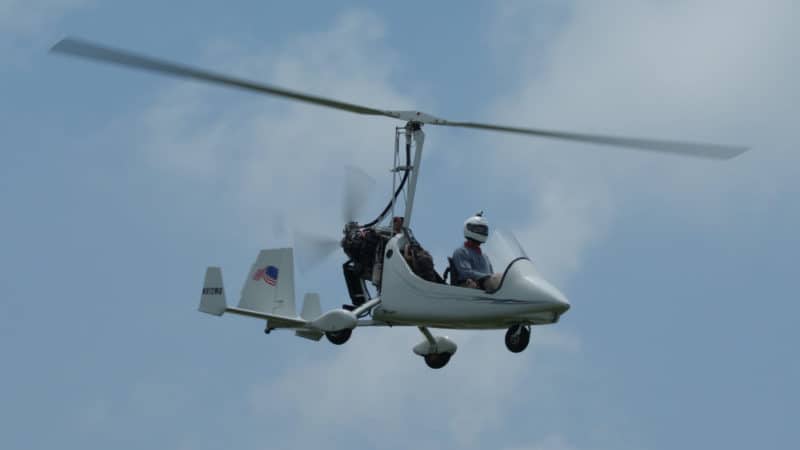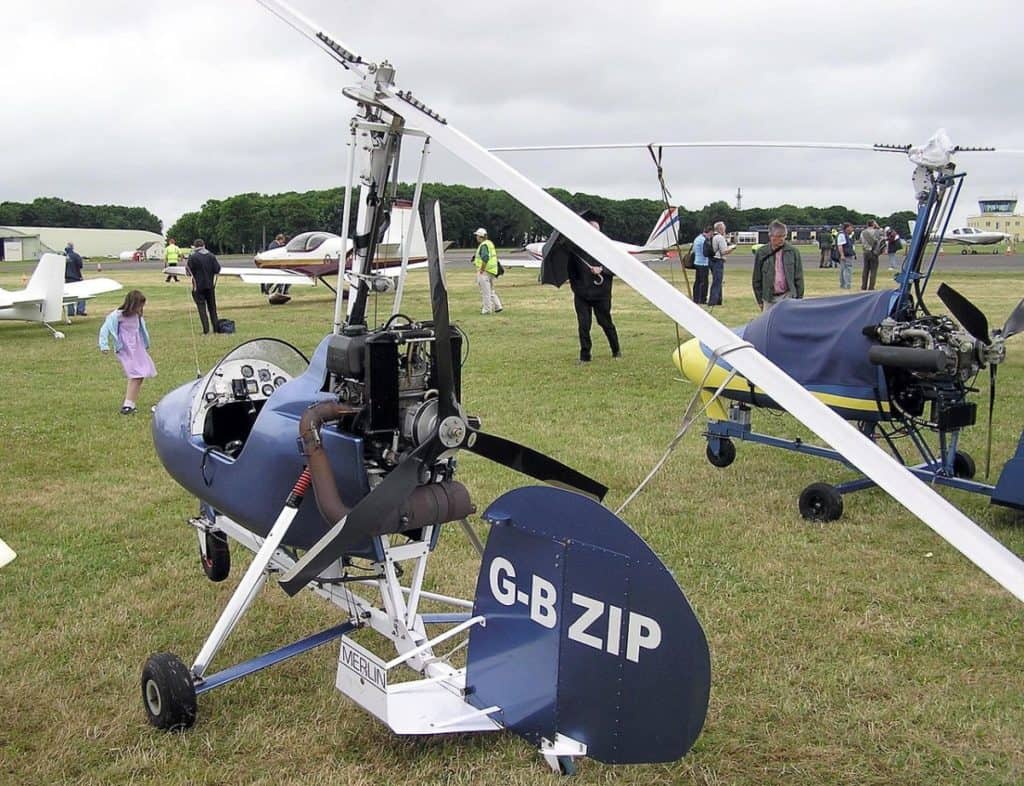
A friend of mine was recently at an airshow and noticed an aircraft that looked like a helicopter but took off like an airplane. Knowing I was a helicopter pilot he asked me what it was. I answered, “It was a Gyrocopter!”.
Gyrocopters have an unpowered, free-spinning main rotor that creates lift as it is propelled through the air by a pusher prop. Helicopters create lift by an engine turning a main rotor system. This allows helicopters to hover and complete very slow flights whereas gyrocopters are unable.
A gyrocopter, also known as a gyroplane or autogyro, is an aircraft with freely rotating rotors and a propeller that propels the aircraft through the air. As the vertical propellor moves the aircraft forward through the air, this rotates the blades of the main rotor creating downward lift. A helicopter, on the other hand, uses an engine to power its main rotors.
How Does a Gyrocopter Work?
If you look closely, you’ll notice that a gyrocopter is a hybrid of a fixed-wing and a helicopter. Many gyrocopter designs have the traditional tail and control surfaces of an airplane, but a free-spinning rotor, which replaces the wings of the airplane.
Gyrocopters are propelled through the air via a propellor mounted on the rear of the aircraft. The forward airspeed causes its main rotor system to ‘Windmill’ allowing the rotor blades to create lift. No power is sent from the engine to the main rotor system so this aircraft is unable to hover.
When the idea of the gyrocopter was initially developed it was to build a safer aircraft that could compete with fixed-wing aircraft that required higher flying speeds to prevent stalling. An autogyro creates lift with by rotating its main rotor blades, whereas a fixed-wing aircraft generates lift by diverting airflow over the wings.
As previously stated, the source of rotation of the main rotor system is the key difference between helicopters and gyrocopters.
Helicopter rotors are powered by the engine/s, gyrocopter rotors are powered by forward flight.
Some gyrocopters are fitted with a simple tube drive off the engine to help get the rotor up to speed while stationary allowing for shorter take-off distances. The drive does not provide enough rotational power to the main rotor to lift it vertically off the ground.
As the propellor pushes the gyrocopter through the air, the airflow begins to ‘Windmill’ the main rotor system and allow it to create lift.
The gyrocopters rotors are made of airfoil-shaped blades, just like on a regular helicopter. When they travel through the air, each blade deflects air downwards. This provides lift to allow the gyrocopter to fly.
Learn More…
Try These Articles:
* Helicopter or Airplane: Which is Easier To Fly?
* How Much Does It Cost to Rent a Helicopter?
How is a Gyrocopter Different From a Helicopter?
The main difference between a helicopter and a gyrocopter is that gyrocopters cannot hover. This is because a gyrocopter requires forward propulsion to create rotor movement, and thus lift.
A helicopter’s rotor generates both lift and propulsion and is rotated by a shaft attached to a transmission which is driven by an engine or engines.

Another main difference is the lack of a tail rotor on an autogyro. In a regular helicopter the engine that drives the main rotor system creates torque on the fuselage based on Newton’s Third Law of “Every Action has an Equal and Opposite Reaction”.
Because an autogyro has no engine driving the main rotor system there is no torque being imparted onto the fuselage, instead, it uses a rudder similar to an airplane to control yaw while in forward flight.

Join My Newsletter & Get Great Tips, Information and Experiences To Help You Become a Superb Pilot!
Do You Need A License to Fly a Gyrocopter in the US?
To fly a gyrocopter you need to obtain a Private Pilot Certificate with Rotorcraft category and Gyroplane class rating, pass the written examination for the Private Pilot Certificate, and obtain at least a Third Class Aviation Medical Certificate from an Aviation Medical Examiner.
According to the FAA from CFR Part 61.107, a pilot must complete at least the following to meet the requirements to apply for the pilot certificate pilot flight test (Checkride):
- You must log at least 40 hours of flight time which includes:
- at least 20 hours of flight training from a CFI (Certified Flight Instructor) and
- 10 hours of solo flight training.
Is a Gyrocopter Easy to Fly?
Modern gyrocopters are easier to fly and manage than helicopters because of their free-rotating rotors and simplified flight controls. They’re a good choice for pleasurable, smooth low-altitude flying because of their low-speed characteristics, and are much cheaper to purchase and operate compared to a helicopter.
In a helicopter, learning to hover is by far the hardest part of learning to fly. Helicopters act like a pendulum causing any pilot-induced sway to amplify until the helicopter is in a very uncomfortable attitude.
Add to that the slight control delays between the pilot initiating a control input and the reaction taking place, it can really make for a wild ride in the first 10-20 hours of learning to fly a helicopter!
Because a gyrocopter has to be propelled through the air like an airplane, the pilot does not have to learn the art of hovering and this allows a gyrocopter to be learned far easier and quicker than a helicopter.
Gyrocopters are very popular in Europe and North America allowing many people to experience the thrill of flight that cannot afford to do so in a traditional airplane or helicopter.
Learn More…
Try These Articles:
* People With Disabilities: Can They Become a Pilot?
* Can Pilots Have Glasses, LASIK or Contact Lenses?
Is a Gyrocopter Safer Than a Helicopter?
As a light aircraft, an autogyro is susceptible to increased passenger injury during an accident due to the lack of structure surrounding them. To keep gyrocopters as light as possible the cabin surrounding the passengers is removed or is very minimal, this prevents exposure during an accident.
Autogyros have great low-speed flight characteristics but the ability to come to a stop and hover can prevent issues especially if the pilot has misjudged their landing and takeoff locations or they suddenly find the ground over which they are rolling suddenly becomes uneven.
Both gyrocopters and helicopters have the ability to enter into autorotation in the event the engine stops working. Autorotation is a maneuver that allows the upflowing air as the aircraft descends to keep turning the main rotor system. This is storing potential energy.
As the aircraft glides closer to the ground the pilot will pitch the nose of the aircraft up and turn that stored potential energy into lift to cushion the landing. Done correctly both a helicopter and an autogyro can touchdown at practically zero forward airspeed.
For Autogyros with only 2 main rotor blades, they are susceptible to Mast-Bumping just like any two-bladed helicopter. If that aircraft enters into a Low-G flight regime the unloading of the main rotor can cause it to separate from its mast – Always a fatal outcome.
With good training, piloting technique, and adherence to the aircraft limitations an autogyro can be as safe as any helicopter.

